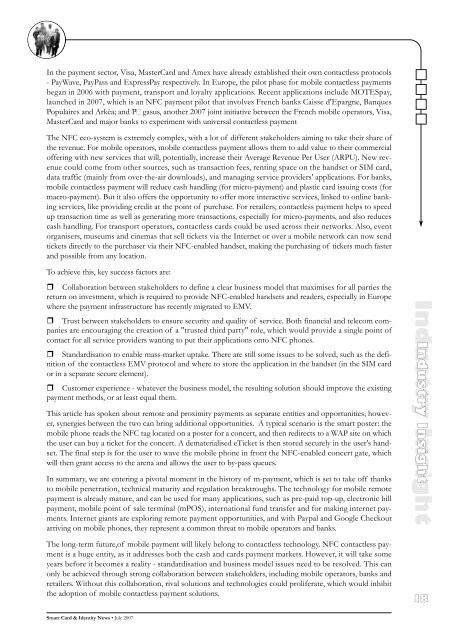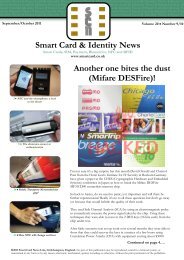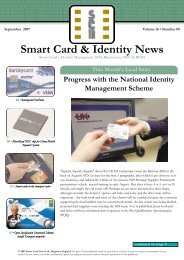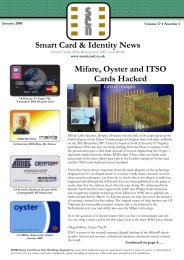Smart Card Identity News - Smart Card News
Smart Card Identity News - Smart Card News
Smart Card Identity News - Smart Card News
Create successful ePaper yourself
Turn your PDF publications into a flip-book with our unique Google optimized e-Paper software.
In the payment sector, Visa, Master<strong>Card</strong> and Amex have already established their own contactless protocols<br />
- PayWave, PayPass and ExpressPay respectively. In Europe, the pilot phase for mobile contactless payments<br />
began in 2006 with payment, transport and loyalty applications. Recent applications include MOTESpay,<br />
launched in 2007, which is an NFC payment pilot that involves French banks Caisse d'Epargne, Banques<br />
Populaires and Arkéa; and P€gasus, another 2007 joint initiative between the French mobile operators, Visa,<br />
Master<strong>Card</strong> and major banks to experiment with universal contactless payment<br />
The NFC eco-system is extremely complex, with a lot of different stakeholders aiming to take their share of<br />
the revenue. For mobile operators, mobile contactless payment allows them to add value to their commercial<br />
offering with new services that will, potentially, increase their Average Revenue Per User (ARPU). New revenue<br />
could come from other sources, such as transaction fees, renting space on the handset or SIM card,<br />
data traffic (mainly from over-the-air downloads), and managing service providers' applications. For banks,<br />
mobile contactless payment will reduce cash handling (for micro-payment) and plastic card issuing costs (for<br />
macro-payment). But it also offers the opportunity to offer more interactive services, linked to online banking<br />
services, like providing credit at the point of purchase. For retailers, contactless payment helps to speed<br />
up transaction time as well as generating more transactions, especially for micro-payments, and also reduces<br />
cash handling. For transport operators, contactless cards could be used across their networks. Also, event<br />
organisers, museums and cinemas that sell tickets via the Internet or over a mobile network can now send<br />
tickets directly to the purchaser via their NFC-enabled handset, making the purchasing of tickets much faster<br />
and possible from any location.<br />
To achieve this, key success factors are:<br />
! Collaboration between stakeholders to define a clear business model that maximises for all parties the<br />
return on investment, which is required to provide NFC-enabled handsets and readers, especially in Europe<br />
where the payment infrastructure has recently migrated to EMV.<br />
! Trust between stakeholders to ensure security and quality of service. Both financial and telecom companies<br />
are encouraging the creation of a "trusted third party" role, which would provide a single point of<br />
contact for all service providers wanting to put their applications onto NFC phones.<br />
! Standardisation to enable mass-market uptake. There are still some issues to be solved, such as the definition<br />
of the contactless EMV protocol and where to store the application in the handset (in the SIM card<br />
or in a separate secure element).<br />
! Customer experience - whatever the business model, the resulting solution should improve the existing<br />
payment methods, or at least equal them.<br />
This article has spoken about remote and proximity payments as separate entities and opportunities; however,<br />
synergies between the two can bring additional opportunities. A typical scenario is the smart poster: the<br />
mobile phone reads the NFC tag located on a poster for a concert, and then redirects to a WAP site on which<br />
the user can buy a ticket for the concert. A dematerialised eTicket is then stored securely in the user's handset.<br />
The final step is for the user to wave the mobile phone in front the NFC-enabled concert gate, which<br />
will then grant access to the arena and allows the user to by-pass queues.<br />
In summary, we are entering a pivotal moment in the history of m-payment, which is set to take off thanks<br />
to mobile penetration, technical maturity and regulation breaktroughs. The technology for mobile remote<br />
payment is already mature, and can be used for many applications, such as pre-paid top-up, electronic bill<br />
payment, mobile point of sale terminal (mPOS), international fund transfer and for making internet payments.<br />
Internet giants are exploring remote payment opportunities, and with Paypal and Google Checkout<br />
arriving on mobile phones, they represent a common threat to mobile operators and banks.<br />
Industry Insight<br />
The long-term future,of mobile payment will likely belong to contactless technology. NFC contactless payment<br />
is a huge entity, as it addresses both the cash and cards payment markets. However, it will take some<br />
years before it becomes a reality - standardisation and business model issues need to be resolved. This can<br />
only be achieved through strong collaboration between stakeholders, including mobile operators, banks and<br />
retailers. Without this collaboration, rival solutions and technologies could proliferate, which would inhibit<br />
the adoption of mobile contactless payment solutions.<br />
18<br />
<strong>Smart</strong> <strong>Card</strong> & <strong>Identity</strong> <strong>News</strong> • July 2007
















